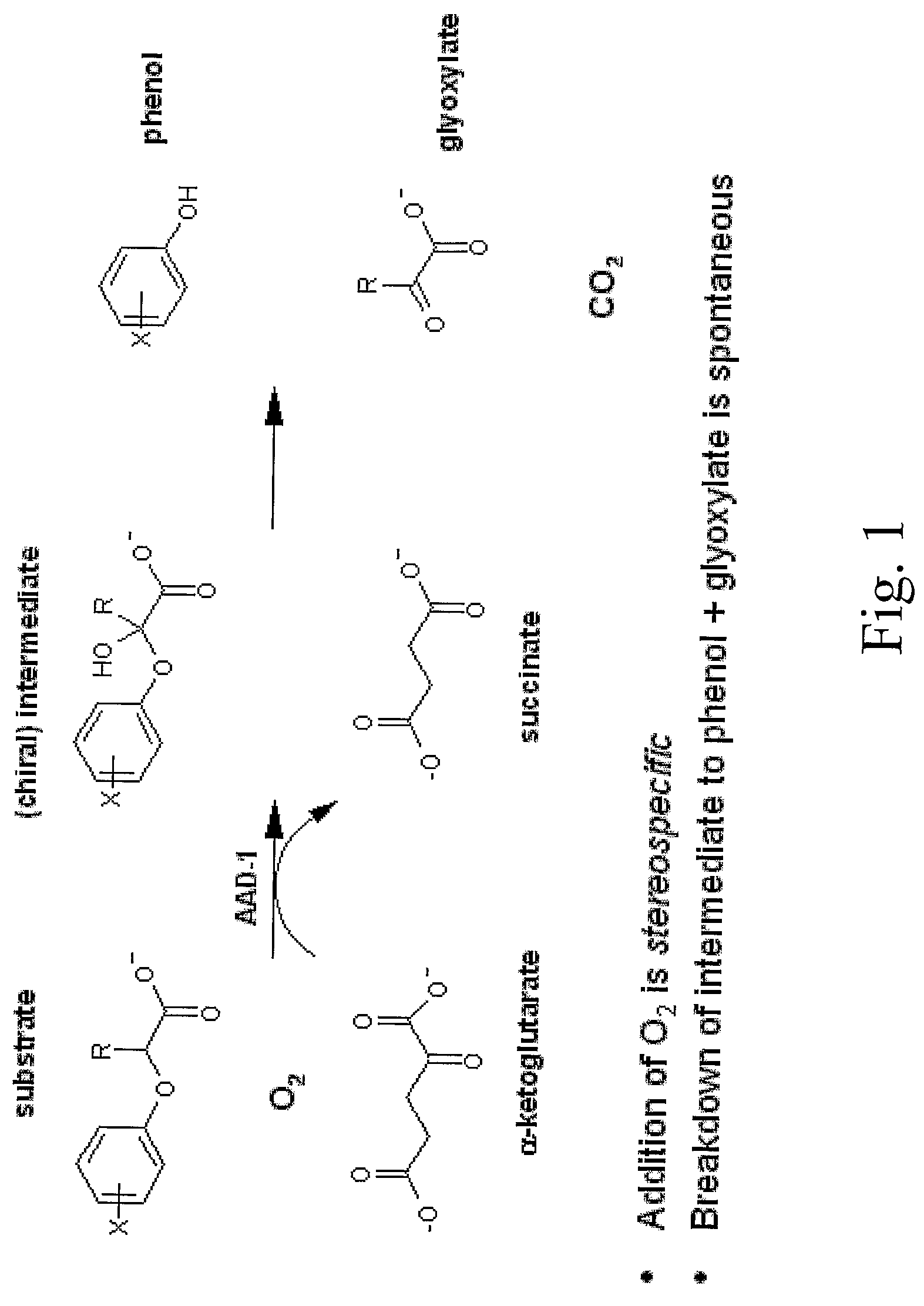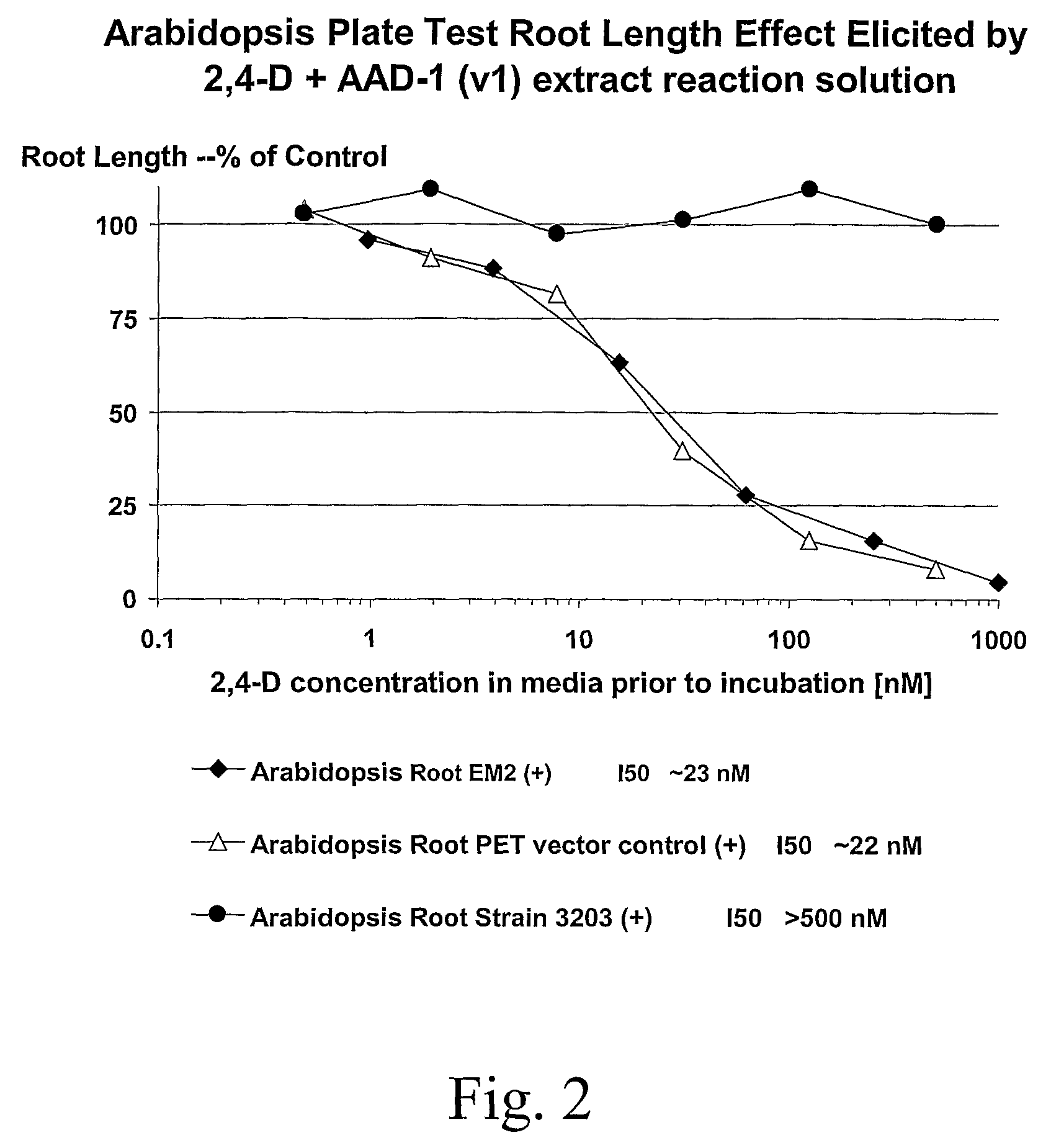Herbicide resistance genes
a technology of herbicide resistance and genes, applied in the field of herbicide resistance genes, can solve the problems of few conventional weed control programs that can effectively compete on price and performance, the cost of glyphosate has dropped dramatically, and the prevalence of gtcs is now increasing
- Summary
- Abstract
- Description
- Claims
- Application Information
AI Technical Summary
Benefits of technology
Problems solved by technology
Method used
Image
Examples
example 1
Method for Identifying Genes that Impart Resistance to 2,4-D In Planta
[0184]As a way to identify genes which possess herbicide degrading activities in planta, it is possible to mine current public databases such as NCBI (National Center for Biotechnology Information). To begin the process, it is necessary to have a functional gene sequence already identified that encodes a protein with the desired characteristics (i.e., α-ketoglutarate dioxygenase activity). This protein sequence is then used as the input for the BLAST (Basic Local Alignment Search Tool) (Altschul et al, 1997) algorithm to compare against available NCBI protein sequences deposited. Using default settings, this search returns upwards of 100 homologous protein sequences at varying levels. These range from highly identical (85-98%) to very low identity (23-32%) at the amino acid level. Traditionally only sequences with high homology would be expected to retain similar properties to the input sequence. In this case we c...
example 2
Expression and Testing
[0192]2.1—HPLC Analysis.
[0193]Plasmid pDAB 3203 was maintained frozen at −80° C. in TOP10F′ cells (Invitrogen) as Dow Recombinant strain DR 1878. For expression, plasmid DNA purified from TOP10F′ culture using Promega's Wizard kit (Fisher cat. #PR-A1460) was transformed into BL-21 Star (DE3) cells (Invitrogen cat. #C6010-03) following manufacturer's protocol. After transformation, 50 μl of the cells were plated onto LB S / S agar plates and incubated overnight at 37° C.
[0194]The next morning, all colonies from the entire plate were scraped into 100 mls LB in a 500 ml tri-baffled flask and incubated at 37° C. / 200 rpm for 1 hr. Gene expression was then induced with 1 mM IPTG, and incubated for 4 hrs at 30° C. / 200 rpm. All 100 ml of culture was centrifuged at 4000 rpm for 20 min. The supernatants were then discarded, and the pellets were resuspended in 10 ml of 50 mM MOPS. These were then subjected to three 45-sec rounds of sonication to lyse the cells. Following th...
example 3
In Vitro Assay of AAD-1 (v1) Activity via Colorimetric Phenol Detection
[0214]3.1—AAD-1 (v1) Assay.
[0215]AAD-1 (v1) enzyme activity was measured by colorimetric detection of the product phenol using a protocol modified from that of Fukumori and Hausinger (1993) (J. Biol. Chem. 268: 24311-24317) to enable deployment in a 96-well microplate format. The colorimetric assay has been described for use in measuring the activity of dioxygenases cleaving 2,4-D and dichlorprop to release the product 2,4-dichlorophenol. However, other phenols could potentially be released from different aryloxyalkanoate herbicides such as haloxyfop and cyhalofop (see FIG. 4). The color yield from several phenols was compared to that of 2,4-dichlorophenol using the detection method previously described to ascertain which phenol products could be readily detected. Phenols and phenol analogs were tested at a final concentration of 100 μM in 0.15 ml 20 mM MOPS pH 6.75 containing 200 μM NH4(FeSO4)2, 200 μM sodium as...
PUM
| Property | Measurement | Unit |
|---|---|---|
| herbicide resistance | aaaaa | aaaaa |
| resistance | aaaaa | aaaaa |
| concentration | aaaaa | aaaaa |
Abstract
Description
Claims
Application Information
 Login to View More
Login to View More - R&D
- Intellectual Property
- Life Sciences
- Materials
- Tech Scout
- Unparalleled Data Quality
- Higher Quality Content
- 60% Fewer Hallucinations
Browse by: Latest US Patents, China's latest patents, Technical Efficacy Thesaurus, Application Domain, Technology Topic, Popular Technical Reports.
© 2025 PatSnap. All rights reserved.Legal|Privacy policy|Modern Slavery Act Transparency Statement|Sitemap|About US| Contact US: help@patsnap.com



